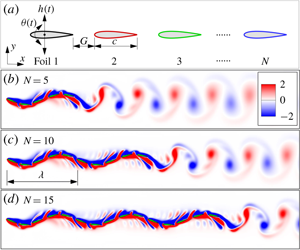Crossref Citations
This article has been cited by the following publications. This list is generated based on data provided by
Crossref.
Huang, Qiaogao
Zhang, Dong
and
Pan, Guang
2020.
Computational Model Construction and Analysis of the Hydrodynamics of a Rhinoptera Javanica.
IEEE Access,
Vol. 8,
Issue. ,
p.
30410.
Lin, Xingjian
Wu, Jie
Zhang, Tongwei
and
Yang, Liming
2021.
Flow-mediated organization of two freely flapping swimmers.
Journal of Fluid Mechanics,
Vol. 912,
Issue. ,
Kang, Linlin
Peng, Ze-Rui
Huang, Haibo
Lu, Xi-Yun
and
Cui, Weicheng
2021.
Active external control effect on the collective locomotion of two tandem self-propelled flapping plates.
Physics of Fluids,
Vol. 33,
Issue. 10,
Jeong, Young Dal
Lee, Jae Hwa
and
Park, Sung Goon
2021.
Flow-mediated interactions between two self-propelled flexible fins near sidewalls.
Journal of Fluid Mechanics,
Vol. 913,
Issue. ,
Heydari, Sina
and
Kanso, Eva
2021.
School cohesion, speed and efficiency are modulated by the swimmers flapping motion.
Journal of Fluid Mechanics,
Vol. 922,
Issue. ,
Li, Xiaohu
Gu, Jiayang
Su, Zhen
and
Yao, Zhenqiu
2021.
Hydrodynamic analysis of fish schools arranged in the vertical plane.
Physics of Fluids,
Vol. 33,
Issue. 12,
Ramos-Docampo, Miguel A.
Brodszkij, Edit
Ceccato, Marcel
Foss, Morten
Folkjær, Mads
Lock, Nina
and
Städler, Brigitte
2021.
Surface polymerization induced locomotion.
Nanoscale,
Vol. 13,
Issue. 22,
p.
10035.
Zhang, Dong
Huang, Qiao-Gao
Pan, Guang
Yang, Li-Ming
and
Huang, Wei-Xi
2022.
Vortex dynamics and hydrodynamic performance enhancement mechanism in batoid fish oscillatory swimming.
Journal of Fluid Mechanics,
Vol. 930,
Issue. ,
Meng, Xueguang
Chen, Zengshuang
Zhang, Yang
and
Chen, Gang
2022.
Aerodynamic performance and flow mechanism of multi-flapping wings with different spatial arrangements.
Physics of Fluids,
Vol. 34,
Issue. 2,
Arranz, G.
Flores, O.
and
García-Villalba, M.
2022.
Flow interaction of three-dimensional self-propelled flexible plates in tandem.
Journal of Fluid Mechanics,
Vol. 931,
Issue. ,
Yang, Dewu
and
Wu, Jie
2022.
Hydrodynamic Interaction of Two Self-Propelled Fish Swimming in a Tandem Arrangement.
Fluids,
Vol. 7,
Issue. 6,
p.
208.
Lin, Xingjian
Wu, Jie
Yang, Liming
and
Dong, Hao
2022.
Two-dimensional hydrodynamic schooling of two flapping swimmers initially in tandem formation.
Journal of Fluid Mechanics,
Vol. 941,
Issue. ,
Chen, Zhe
Li, Xiong
and
Chen, Long
2022.
Enhanced performance of tandem plunging airfoils with an asymmetric pitching motion.
Physics of Fluids,
Vol. 34,
Issue. 1,
Zhang, Dong
Zhang, Jun-Duo
and
Huang, Wei-Xi
2022.
Physical models and vortex dynamics of swimming and flying: a review.
Acta Mechanica,
Vol. 233,
Issue. 4,
p.
1249.
Liu, Xuechao
Liu, Kui
and
Huang, Haibo
2022.
Collective behavior and hydrodynamic advantage of side-by-side self-propelled flapping foils.
Physical Review E,
Vol. 105,
Issue. 6,
Wu, Jianghao
Li, Gang
Chen, Long
and
Zhang, Yanlai
2022.
Unsteady aerodynamic performance of a tandem flapping–fixed airfoil configuration at low Reynolds number.
Physics of Fluids,
Vol. 34,
Issue. 11,
Zeng, Yuhang
Wang, Yan
Yang, Dangguo
and
Chen, Qing
2023.
Immersed Boundary Methods for Simulations of Biological Flows in Swimming and Flying Bio-Locomotion: A Review.
Applied Sciences,
Vol. 13,
Issue. 7,
p.
4208.
Gao, Pengcheng
Huang, Qiaogao
Pan, Guang
Liu, Jing
Shi, Yao
He, Xing
and
Tian, Xushun
2023.
Hydrodynamic performance of manta rays under different motion parameter.
IOP Conference Series: Materials Science and Engineering,
Vol. 1288,
Issue. 1,
p.
012035.
Kelly, John
and
Menzer, Alec
2023.
Hydrodynamics of body–body interactions in dense synchronous elongated fish schools.
Physics of Fluids,
Vol. 35,
Issue. 4,
2023.
Research on swimming performance of fish in different species.
Physics of Fluids,
Vol. 35,
Issue. 6,


